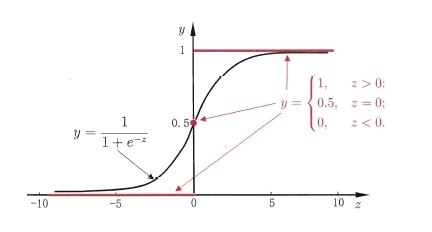
# ----------
#
# There are two functions to finish:
# First, in activate(), write the sigmoid activation function.
# Second, in update(), write the gradient descent update rule. Updates should be
# performed online, revising the weights after each data point.
#
# ----------
import numpy as np
class Sigmoid:
"""
This class models an artificial neuron with sigmoid activation function.
"""
def __init__(self, weights = np.array([1])):
"""
Initialize weights based on input arguments. Note that no type-checking
is being performed here for simplicity of code.
"""
self.weights = weights
# NOTE: You do not need to worry about these two attribues for this
# programming quiz, but these will be useful for if you want to create
# a network out of these sigmoid units!
self.last_input = 0 # strength of last input
self.delta = 0 # error signal
def activate(self, values):
"""
Takes in @param values, a list of numbers equal to length of weights.
@return the output of a sigmoid unit with given inputs based on unit
weights.
"""
# YOUR CODE HERE
# First calculate the strength of the input signal.
strength = np.dot(values, self.weights)
self.last_input = strength
# TODO: Modify strength using the sigmoid activation function and
# return as output signal.
# HINT: You may want to create a helper function to compute the
# logistic function since you will need it for the update function.
result = self.logistic(strength)
return result
def logistic(self,strength):
return 1/(1+np.exp(-strength))
def update(self, values, train, eta=.1):
"""
Takes in a 2D array @param values consisting of a LIST of inputs and a
1D array @param train, consisting of a corresponding list of expected
outputs. Updates internal weights according to gradient descent using
these values and an optional learning rate, @param eta.
"""
# TODO: for each data point...
for X, y_true in zip(values, train):
# obtain the output signal for that point
y_pred = self.activate(X)
# YOUR CODE HERE
# TODO: compute derivative of logistic function at input strength
# Recall: d/dx logistic(x) = logistic(x)*(1-logistic(x))
dx = self.logistic(self.last_input)*(1 - self.logistic(self.last_input) )
print ("dx{}:".format(dx))
print ('
')
# TODO: update self.weights based on learning rate, signal accuracy,
# function slope (derivative) and input value
delta_w = eta * (y_true - y_pred) * dx * X
print ("delta_w:{} weight before {}".format(delta_w, self.weights))
self.weights += delta_w
print ("delta_w:{} weight after {}".format(delta_w, self.weights))
print ('
')
def test():
"""
A few tests to make sure that the perceptron class performs as expected.
Nothing should show up in the output if all the assertions pass.
"""
def sum_almost_equal(array1, array2, tol = 1e-5):
return sum(abs(array1 - array2)) < tol
u1 = Sigmoid(weights=[3,-2,1])
assert abs(u1.activate(np.array([1,2,3])) - 0.880797) < 1e-5
u1.update(np.array([[1,2,3]]),np.array([0]))
assert sum_almost_equal(u1.weights, np.array([2.990752, -2.018496, 0.972257]))
u2 = Sigmoid(weights=[0,3,-1])
u2.update(np.array([[-3,-1,2],[2,1,2]]),np.array([1,0]))
assert sum_almost_equal(u2.weights, np.array([-0.030739, 2.984961, -1.027437]))
if __name__ == "__main__":
test()
OUTPUT
Running test()...
dx0.104993585404:
delta_w:[-0.0092478 -0.01849561 -0.02774341] weight before [3, -2, 1]
delta_w:[-0.0092478 -0.01849561 -0.02774341] weight after [ 2.9907522 -2.01849561 0.97225659]
dx0.00664805667079:
delta_w:[-0.00198107 -0.00066036 0.00132071] weight before [0, 3, -1]
delta_w:[-0.00198107 -0.00066036 0.00132071] weight after [ -1.98106867e-03 2.99933964e+00 -9.98679288e-01]
dx0.196791859198:
delta_w:[-0.02875794 -0.01437897 -0.02875794] weight before [ -1.98106867e-03 2.99933964e+00 -9.98679288e-01]
delta_w:[-0.02875794 -0.01437897 -0.02875794] weight after [-0.03073901 2.98496067 -1.02743723]
All done!
